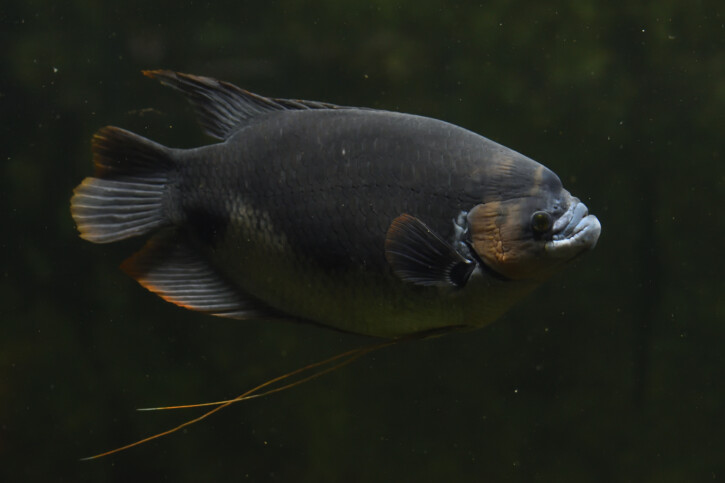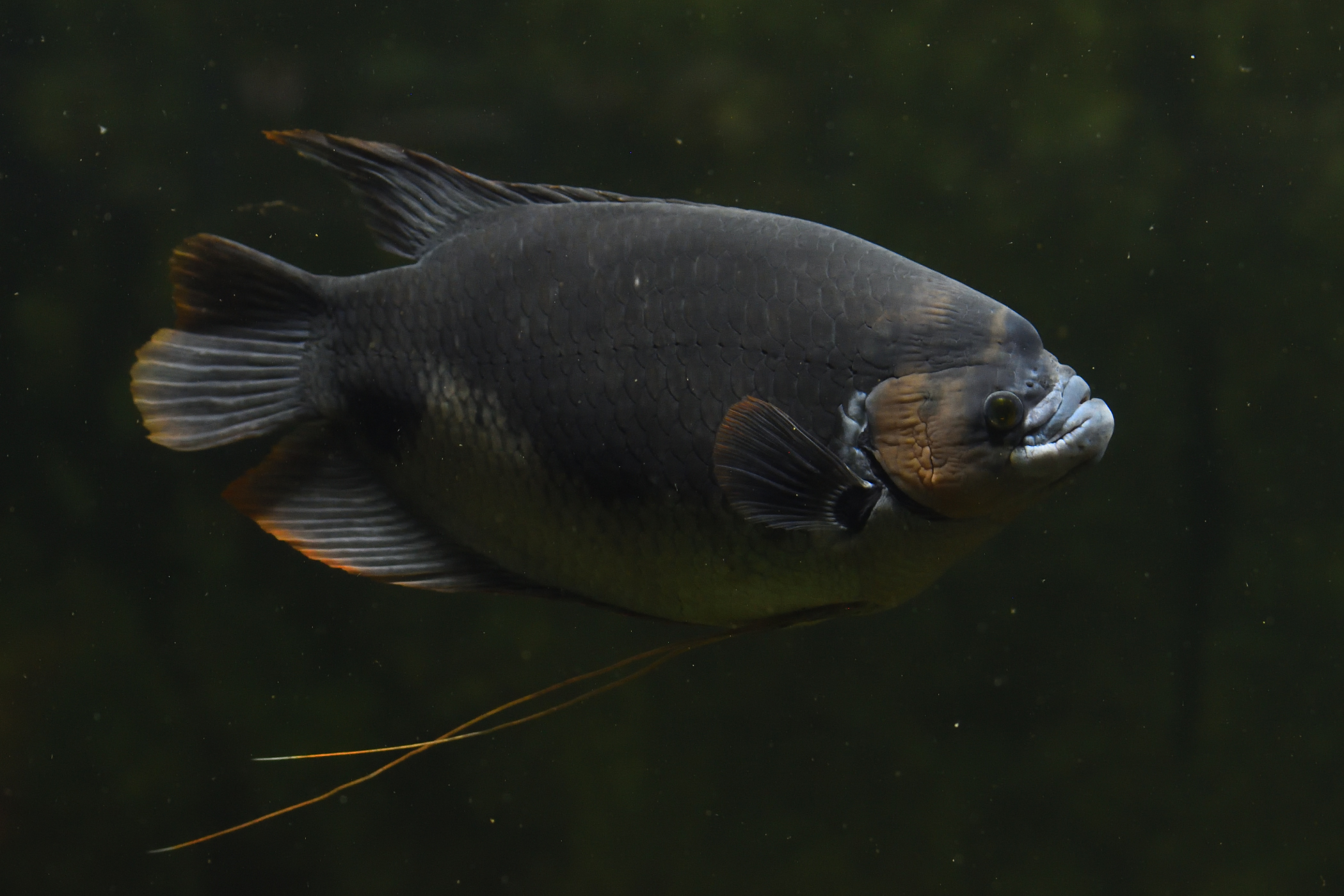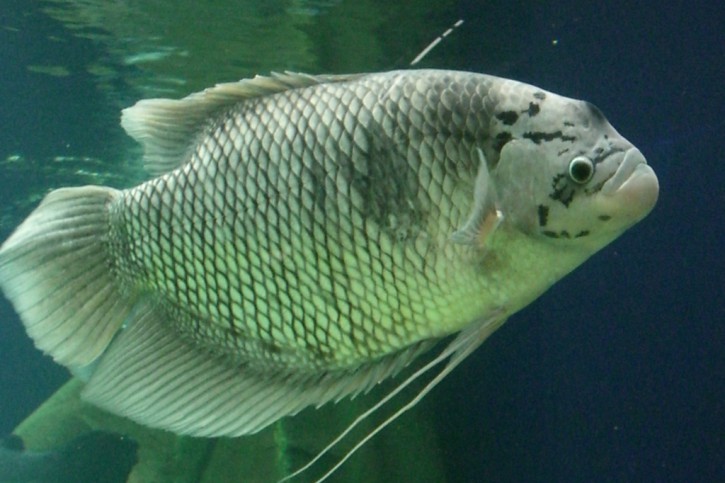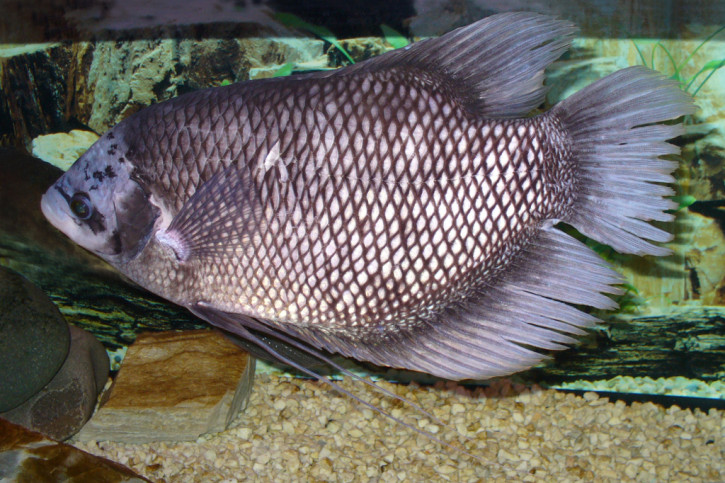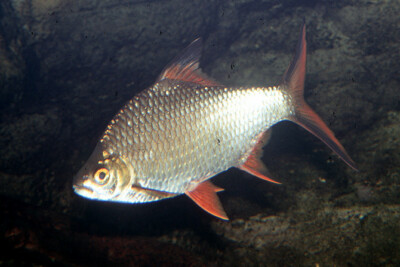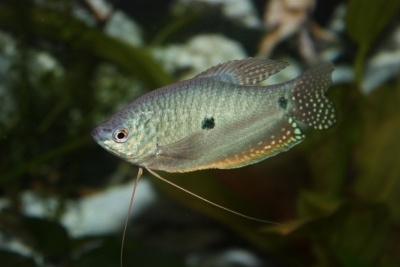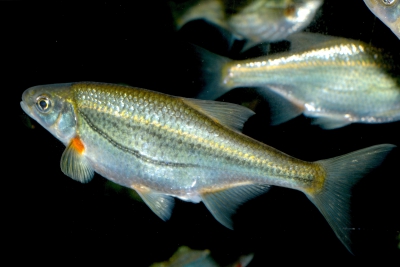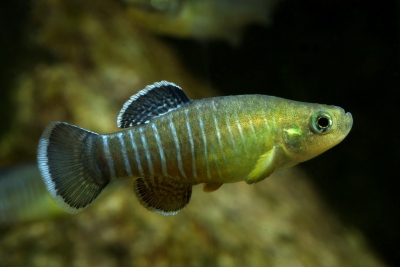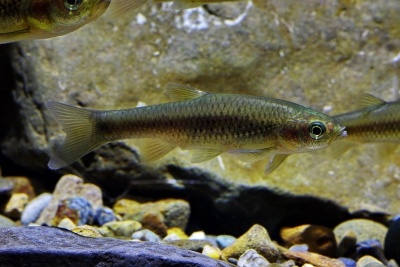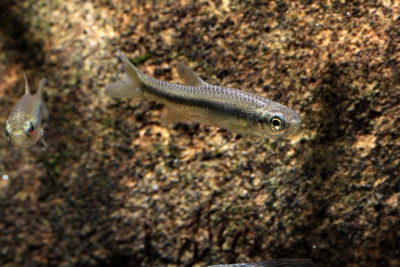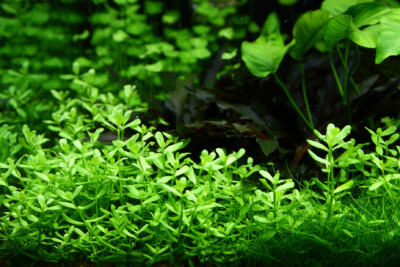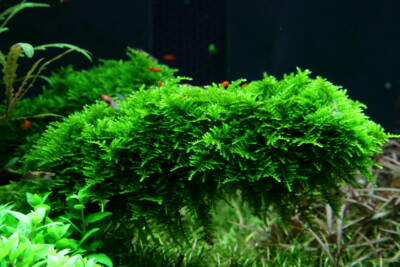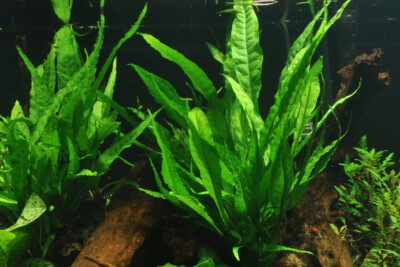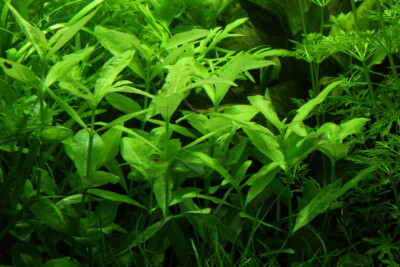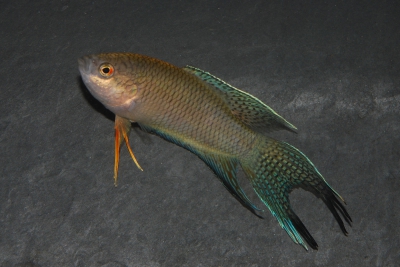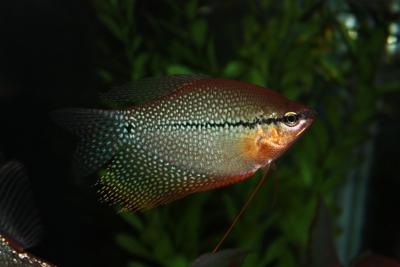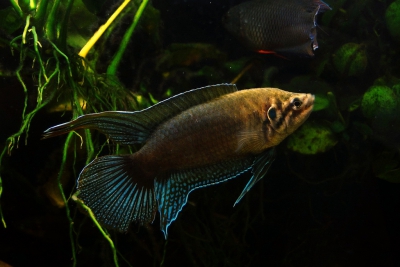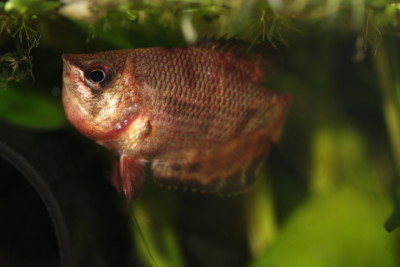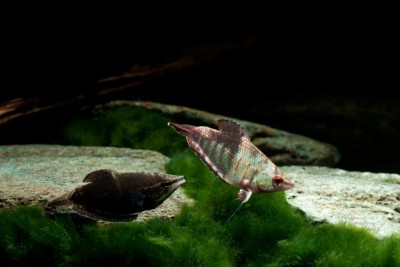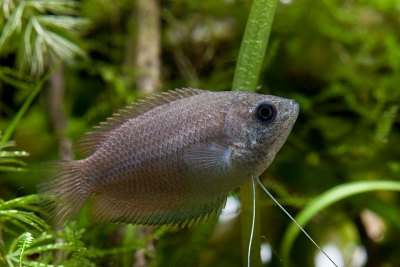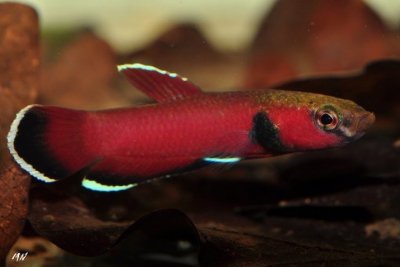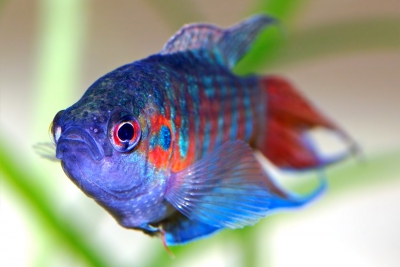Introduction
Osphronemus goramy, commonly known as giant gourami, is a fresh water fish from the Asia.
This sheet is currently being prepared. The texts currently proposed come from our data model or are being drafted. To request priority for this content, you can write to us HERE.
Who is it?
Morphology
-
Average size45 cm
-
Maximum size70 cm
-
Longevity25 year
-
Average size45 cm
-
Maximum size70 cm
-
Longevity25 year
How to recognize This fish ?
Like all fish of its genus, the giant gourami has the particularity of being able to breathe in two different ways. In addition to the classic gills, this species is equipped with a breathing apparatus called Labyrinthe which allows it to absorb oxygen from the air. These species are commonly called the labyrinth Fish.
The giant gourami measures between 45 and 70 cm. This fish is unicolore with a predominantly gris body.
Behaviour & Life cycle
-
dietomnivorous with carnivorous tendency
-
Sociabilityliving in shoals
-
territorialNo
-
Way of livingdiurnal
The giant gourami is a fish living in shoals naturally found mid-depth and near surface. This species is omnivorous with carnivorous tendency .
Although the giant gourami is non-territorial, it is sometimes aggressive towards other species.
Reproduction
-
Reproductionovipare réalisant des nids de bulles
The giant gourami is a fish ovipare réalisant des nids de bulles. This fish protects its eggs from nearby predators.
Harmless species
This species does not represent any particular threats to humans when encountered in its natural environment.
Origin and distribution
What is its habitat?
Natural environment characteristics
-
Temperature20 - 30 °C
-
pH (acidity)6.5 - 8
-
gh (hardness)20 - 25
Biotope presentation
The giant gourami is most often found at a depth between 0m and 10m. However, it is not impossible to find this species at other depths. This animal evolves in areas characterized by a strong presence of vegetation (aquatic and marsh plants, decaying organic matter, roots...).
This species lives near large roots, in which it can find refuge in case of danger. This type of habitat is often found not far from the banks.
During dry periods, the giant gourami may find themselves isolated in marshes and small water holes with little oxygen. Its ability to gasp for air at the surface allows it to resist until the next season.
Species of the same biotope
Main recommendations for fishkeeping
Deontology
In order to preserve wildlife, if you acquire this animal, it must not be released into the wild. See also, the Fishipedia charter.
Fishipedia supports the practice of responsible and environmentally friendly aquarium keeping. We encourage maintenance if it is motivated by a desire to understand the biological functioning of living things and if it is done with respect for animal life.
We believe that aquaristics is an opening to the discovery of aquatic environments, especially freshwater, and that this knowledge is necessary to better protect and respect these environments. Logically, we refute the compulsive purchase of animals that would not find a sufficient and / or adapted place in the host aquarium.
Our recommendations
-
Min volume5000 liters
-
Population minnot specified
-
Temperature20 - 30 °C
-
pH (acidity)6.5 - 8
Characteristics
-
Difficulty breedingmoderate
-
Behaviourslightly aggressive
General reminders
It is strongly advised to read the complete dedicated file and to get information on the feedbacks of maintenance of the envisaged animal, this to avoid any potential conflict whose end result is generally the death of the individual (or the other inhabitants). It is important not to overload your aquarium to limit pollution. This will make maintenance easier.
In nature, animals are subject to weather conditions and live in waters with variable characteristics. The recommendations offered by our team for aquarium maintenance are a guidance and cannot be assimilated to scientific datas.
General reminder on maintenance datas
Le démarrage d'un aquarium est une partie primordiale pour l'équilibre et le bien-être des poissons. Lorsque l'on met en eau un aquarium, l'eau passe naturellement par un cycle biologique : le cycle de l'azote. Celui-ci dure environ trois semaines. Tous les 2 jours, nous vous conseillons de tester votre eau jusqu'à ce que le taux de nitrite soit à zéro pendant plusieurs jours d'affilée.
Pour accélérer ce cycle, vous pouvez utiliser un activateur de bactéries comme JBL Denitrol. Cette solution riche en bactéries vivantes et enzymes permet une mise en place rapide du cycle de l'azote. Les poissons peuvent alors être introduits plus rapidement.
Il est important de tester l'eau de son aquarium régulièrement pour maintenir un environnement sain pour les poissons et les autres habitants. Les tests d'eau permettent de mesurer les niveaux de différents paramètres tels que le pH, la dureté totale, ainsi que les taux de nitrates, de nitrites et d'ammoniaque.
Pour réaliser ces tests, vous pouvez utiliser des produits d'analyse spécialisés tels que JBL ProScan qui permet de réaliser un diagnostic de l'eau directement via un smartphone. Il existe également des coffrets de tests plus classiques de bandelettes, comme JBL PROAQUATEST.
En cas d’usage de l’eau du robinet, vous pouvez utiliser un conditionneur d’eau de type Biotopol de JBL pour éliminer les substances nocives comme le chlore, le cuivre, le plomb et le zinc. Une eau trop dure ou trop calcaire peut être inadaptée à de nombreuses espèces tropicales d’eau douce. Si nécessaire, vous pouvez la couper avec de l’eau osmosée ou de pluie filtrée afin d’obtenir une dureté plus adaptée aux besoins de vos poissons et de vos plantes. Les conditionneurs d'eau garantissent une meilleure santé aux poissons et une meilleure croissance des plantes.
Chlorine and chloramine are dangerous for the health of animals. Used to disinfect water, these agents are present in significant quantities in tap water. We recommend using an anti-chlorine agent every time you change the water. In addition to chlorine, treatments and medicines sold for aquarium use sometimes contain dangerous heavy metals in high doses.
Specific needs for the giant gourami
The giant gourami is a species which lives naturally at a temperature between 20 °C and 30 °C. Nitrate levels should remain below 50mg/L. To keep the water clean and unpolluted, plan on changing 20% to 30% of the water volume each month.
The breeding of this species is accessible on condition of being well informed about its needs in aquarium . Any cohabitants must be chosen with care to avoid the loss of animals.
Fish with a maze
The ability to breathe at the surface makes this fish more likely to live in small volumes. Naturally, the giant gourami can be found for long periods in water holes where oxygen is scarce.
Cohabitation & Environment
Being a living in shoals fish, it is advisable to install at least 0 individuals in an aquarium of 5000 liters minimum. Group maintenance is a prerequisite to ensure their well-being. Lonely individuals tend to quickly become stressed and become especially susceptible to disease. Warning, mixing several species living in the same living area is not recommended if the volume is not significant.
The species enjoys a particularly vegetation-rich environment. The addition of plants will provide many useful hiding places for resting. These areas are also conducive to possible breeding in the aquarium.
Tips for feeding
The giant gourami is omnivorous with carnivorous tendency.
This species can eat dry food (flakes, pellets), fresh food and frozen food. To avoid deficiencies, it is recommended to vary the types of food.
Feed animals in moderation to maintain good water quality. Meals should be eaten within 2–3 minutes, served in several small portions rather than a single large ration.
Uneaten food quickly decomposes, releasing ammonia, nitrites, and nitrates, which disturb the aquarium’s biological balance.
Make sure each species can access food properly, slower or bottom-dwelling individuals may require targeted feeding.Reproduction protocol
-
Spawning cleaningFemale
-
egg-laying protectionFemale
-
Fry protectionNo
Hybridization risks
In general, it is advised not to mix several species of the same genus or different varieties of the same species, to avoid the risks of hybridization.
These animals might interest you
These plants might interest you
Plants play a crucial role in aquariums, both for their ability to filter water by absorbing excess nutrients and for their aesthetic contribution. They provide fish with natural hiding places, can serve as breeding sites, and generally help maintain the overall balance and optimal conditions of the aquarium. The selection presented here includes species from the same regions as the species described on this page, although they do not necessarily come from its exact natural biotope.
To go further
Sources & Contributions
Participation & Validation
The Fishipedia team and specialist contributors are committed to providing high-quality content. However, although the information comes from scientific sources or testimonials from specialists, the cards may contain inaccuracies.

Adrien Falzon

Benoit Chartrer
Translation
Translation done with the valuable contribution of our translators, who make this information available to a wider audience. We sincerely thank them for their commitment.
Bibliographic references
- - GBIF
- - Survey on egg and fry production of giant gourami (Osphronemus goramy): Current rearing practices and recommendations for future research - Anang Hari Kristanto - Jacques Slembrouck - Jojo Subagja - Simon Pouil - Otong Zenal Arifin - Vitas Atmadi Prakoso - Marc Legendre - WILEY - 2019.
- - Some aspects in early life stage of giant gourami, Osphronemus goramy (Lacepede) larvae - Thumronk Amornsakun - Surasak Kullai - Anuar Hassan - Songklanakarin Journal of Science and Technology - 2014.
Scientific partners
Tags
Species of the same family
Species of the same biotope
